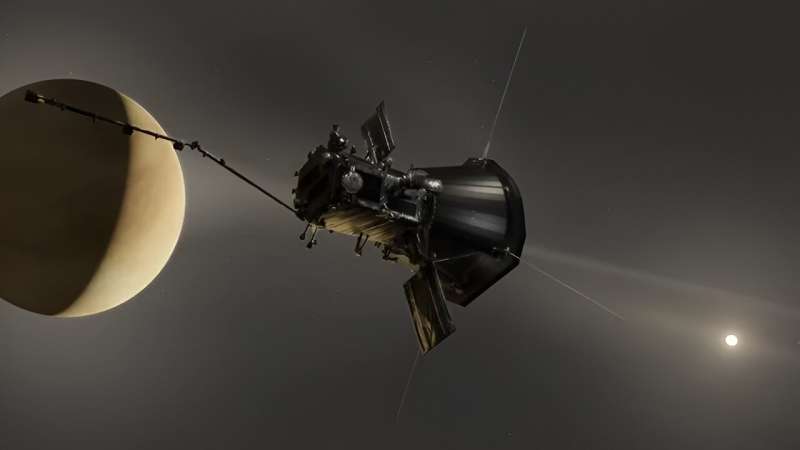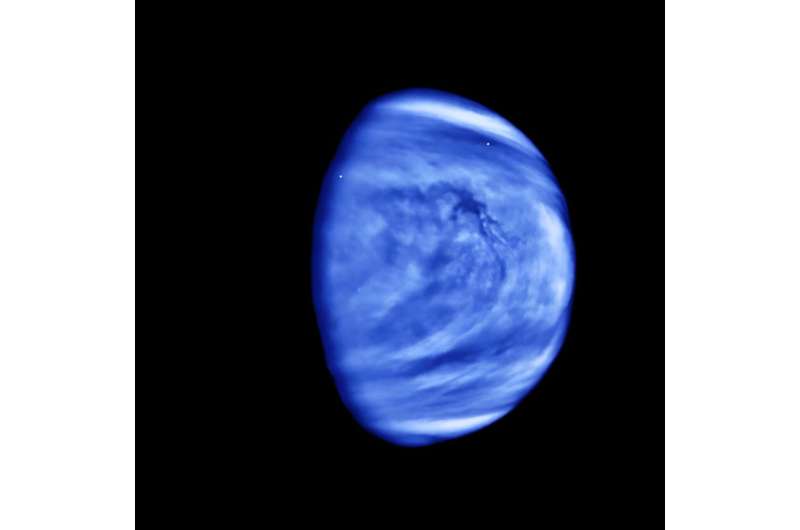This article has been reviewed according to Science X's editorial process and policies. Editors have highlighted the following attributes while ensuring the content's credibility:
fact-checked
peer-reviewed publication
trusted source
proofread
Does lightning strike on Venus? Maybe not, study suggests

Venus may be a (slightly) gentler place than some scientists give it credit for.
In new research, space physicists at CU Boulder have jumped into a surprisingly long-running debate in solar system science: Does lightning strike on the second planet from the sun?
The team's results add strong new evidence suggesting that, no, you probably wouldn't see bolts of lightning flashing from Venus' thick, acidic clouds—or, at least, not very often.
"There's been debate about lightning on Venus for close to 40 years," said Harriet George, lead author of the new study and a postdoctoral researcher at the Laboratory for Atmospheric and Space Physics (LASP). "Hopefully, with our newly available data, we can help to reconcile that debate."
She and her team published their findings in the journal Geophysical Research Letters.
The research takes a deep dive into one of the most mysterious, and inhospitable, bodies in the solar system. Venus is about the same size as Earth, but its dense, carbon dioxide-rich atmosphere has led to a runaway greenhouse effect. Anyone standing on the ground would face searing temperatures of 900 degrees Fahrenheit and crushing atmospheric pressures. No spacecraft has ever survived for more than a few hours on the planet's surface.
To explore this extreme world, the researchers turned to a scientific tool that wasn't designed to study Venus at all: NASA's Parker Solar Probe, which launched in 2018 as part of a 7-year mission to investigate the physics of the sun's corona, or outermost atmosphere, and the solar wind. Parker Solar Probe was designed, built and is now operated by the Johns Hopkins Applied Physics Laboratory, which leads the mission for NASA.
In February 2021, the spacecraft swooped around Venus at a distance of roughly 1,500 miles. In the process, its instruments picked up dozens of what scientists call "whistler waves"—pulses of energy that, on Earth at least, can be kicked off by bolts of lightning. The team's data showed that Venus' whistler waves may not actually originate from lightning, but rather from disturbances in the weak magnetic fields that envelop the planet.
The results agree with a 2021 study, which failed to detect radio waves generated by lightning strikes coming from Venus. The research was led by Marc Pulupa of the University of California, Berkeley.

David Malaspina, a co-author of the new study, said the findings show just how little humans know about one of our nearest neighbors.
"It's very rare that new scientific instruments make it to Venus," said Malaspina, assistant professor at LASP and the Department of Astrophysical and Planetary Sciences. "We don't get a lot of chances to do this kind of interesting research."
Dark and stormy nights
Much of the debate around Venus and lightning dates back to 1978 when a NASA spacecraft called Pioneer Venus entered into orbit around Earth's hotter, angrier twin. Almost immediately, the spacecraft began picking up the signals of whistler waves hundreds of miles above the planet's surface.
For many scientists, these signals were reminiscent of a familiar phenomenon from Earth: lightning.
George explained that, on Earth, whistler waves are often—but not always—created by lightning. Lightning strikes, she said, can jostle electrons in the planet's atmosphere, which then launch waves that spiral out into space. These waves create whistling tones that early radio operators on Earth could hear using headphones, hence the name "whistlers."
If Venus' whistler waves have a similar origin, then the planet might be a monster of lightning, experiencing roughly seven times more strikes than Earth. Scientists have also spotted lightning on Saturn and Jupiter.
"Some scientists saw those signatures and said, "That could be lightning,'" George said. "Others have said, "Actually, it could be something else." There's been back and forth about it for decades since."
A brush with Venus
Parker Solar Probe could offer scientists an opportunity to resolve the debate for good.
George said that the spacecraft will skim by Venus seven times during its mission, using these flybys to draw closer and closer to the sun. In 2021, during its fourth such maneuver, the probe got remarkably near to the planet—passing into the shadow cast behind Venus, a prime spot to go looking for whistler waves.
To find those signals, George, Malaspina and their colleagues used Parker Solar Probe's FIELDS Experiment, a set of electric and magnetic field sensors that stick out from the spacecraft. (A team at CU Boulder and LASP designed and built the Digital Fields Board, which analyzes signals from the FIELDS sensors).
When the researchers analyzed a set of those whistlers, however, they noticed something surprising: Venus' whistler waves were headed the wrong way. They seemed to be moving down toward the planet, not out into space like you'd expect from a lightning storm.
"They were heading backward from what everybody had been imagining for the last 40 years," Malaspina said.
What is causing these backward whistlers isn't clear. George and Malaspina suspect that they may emerge from a phenomenon called magnetic reconnection—in which the twisting magnetic field lines that surround Venus come apart then snap back together with explosive results.
For now, the researchers say they need to analyze more whistlers to completely rule out lightning as a cause. They'll get their next chance in November 2024 when the Parker Solar Probe makes its final pass by Venus, dropping down to less than 250 miles above the surface—brushing the top of the planet's "soupy" atmosphere, Malaspina said.
"Parker Solar Probe is a very capable spacecraft. Everywhere it goes, it finds something new."
More information: H. George et al, Non‐Lightning‐Generated Whistler Waves in Near‐Venus Space, Geophysical Research Letters (2023). DOI: 10.1029/2023GL105426
Journal information: Geophysical Research Letters
Provided by University of Colorado at Boulder





















